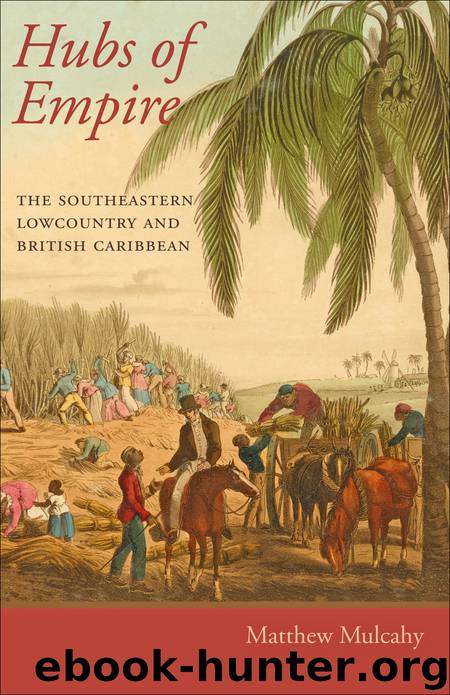Hubs of Empire by Matthew Mulcahy

Author:Matthew Mulcahy
Language: eng
Format: epub
Publisher: Johns Hopkins University Press
Published: 2014-06-14T16:00:00+00:00
FAMILY LIFE, CULTURE, AND RELIGION
Despite horrific demographic conditions, slaves did manage to form families and communities. The historian Philip Morgan rightly cautions that when speaking of slave families, “the problem of applying terminology that presupposes freedom to relationships that were grounded in slavery must always be borne in mind.”12 Slave marriages carried no legal standing, and families faced the constant threat of sale and separation. Nevertheless, over time slaves throughout the Greater Caribbean established meaningful relationships as husbands and wives, parents and children, brothers and sisters, and slave families provided something of a refuge from the dehumanizing brutality of the plantation system.
Detailed and systematic information about the structure of slave families is not abundant for the seventeenth and eighteenth centuries, but it is clear that slaves lived in a variety of household units. These included individuals living alone, households with unrelated individuals of the same sex, one parent (usually the mother) living with children, nuclear families with a husband, wife, and children, as well as polygamous households. The particular arrangements on any one plantation varied over time and reflected a variety of factors, including the number of Africans and creoles in a population. More Africans meant an uneven sex ratio, because the slave trade delivered more men to the colonies, while creole populations tended to have relatively even sex ratios. Nevertheless, a shift toward nuclear families occurred throughout the region over the course of the eighteenth century. In the Lowcountry, the percentage of slaves living in families rose from 52 percent in 1730 to 79 percent in 1790. Two-parent households were the most common form among those family units, followed by children living with a single parent, usually the mother. Similar patterns existed elsewhere in the region. Enslaved Africans on Thomas Thistlewood’s livestock pen in western Jamaica gradually formed themselves into households based on kin links, most frequently nuclear families. At least a few male slaves engaged in polygamy, a practice common in parts of West Africa. One slave on Thistlewood’s pen, for example, a man named Lincoln lived with two wives, five children, and one grandchild. Likewise, an Anglican minister in Carolina felt compelled to remind slaves in his parish that Christianity prohibited multiple wives, which may help explain why so few slaves were interested in missionary efforts. Such examples highlight the persistence of some African cultural forms, but they were not common. Most slaves lived in nuclear families or family units of a mother and her children.
Slave families were simultaneously fragile and strong—fragile because they were subject to constant disruption, but strong because they proved resilient in the face of such challenges. Although planters gradually recognized that families created a degree of stability, many did not hesitate to break them apart when they deemed it economically beneficial to do so. The Price family, for example, owned numerous estates in Jamaica, and they often shifted slaves from one plantation to another with little concern for family life. The Prices separated children from their mothers at age six to put them to work in the fields.
Download
This site does not store any files on its server. We only index and link to content provided by other sites. Please contact the content providers to delete copyright contents if any and email us, we'll remove relevant links or contents immediately.
| Africa | Americas |
| Arctic & Antarctica | Asia |
| Australia & Oceania | Europe |
| Middle East | Russia |
| United States | World |
| Ancient Civilizations | Military |
| Historical Study & Educational Resources |
Pirate Hunter of the Caribbean by David Cordingly(615)
Architecture and Empire in Jamaica by Nelson Louis P(419)
Haitian Connections in the Atlantic World: Recognition After Revolution by Julia Gaffield(399)
Churchill Comes of Age by Hal Klepak(394)
THE HISTORY OF MARY PRINCE, A WEST INDIAN SLAVE by Mary Prince(384)
Sugar in the Blood: A Family's Story of Slavery and Empire by Andrea Stuart(328)
Tacky’s Revolt by Vincent Brown(327)
The Real Pirates of the Caribbean by Colin Woodard(324)
Trinidad's Doctor's Office by Vincent Tothill(310)
Bahamas Bucket List for Divers: Bimini Edition by Nathan Riley(295)
The Cayman Islands in Transition: The Politics, History and Sociology of a Changing Society by J.A. Roy Bodden(294)
The Spirits and the Law: Vodou and Power in Haiti by Kate Ramsey(286)
Policing Life and Death by LeBron Marisol;(269)
An Eye For The Tropics: Tourism, Photography, and Framing the Caribbean Picturesque by Krista A. Thompson(251)
The Cry of Vertières by Jean-Pierre Le Glaunec(248)
Caribbean History by Tony Martin(236)
The New Rum by Bryce T. Bauer(233)
A Brave Vessel: The True Tale of the Castaways Who Rescued Jamestown by Woodward Hobson(231)
A Contemporary Cuba Reader by Brenner Philip; Jiménez Marguerite Rose; Kirk John M(219)
